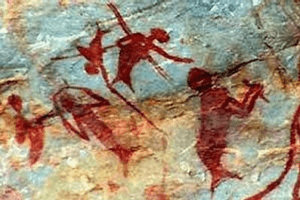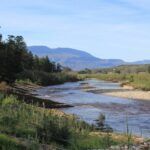The Buffelsjag River is said to be the home of the legendary Kaaiman creatures. These are described as being half human half fish, somewhat like the mermaid legends.
They are said to be malevolent with glowing red eyes and they attempt to drown their victims. The belief is held strongly by locals who can point out several unmarked graves of people who had been lured to a watery death.

These legendary creatures are known in other parts of the country, particularly in the Karoo in rivers and rock pools. “Mermaids are seen sitting on rocks combing their hair. They appear to be in the form of women who lure passersby closer to grab them and drown them.
This is the stuff of mythology, but perhaps not. A family who was picnicking on the banks of the river late one evening in January 2008 had an uncommon experience. One of the men heard a sound like someone bashing against a wall. He went to see what the noise was when he saw a figure that looked like a white woman with long black hair thrashing about in the water. He immediately felt a need to save her, but as he waded towards her she looked around and he saw her red glowing eyes. He was unable to move as it seemed as if he was hypnotized, but he called for his friends to come and see. The man’s friends confirmed what he saw and reported the creature making the strangest sound, like sorrowful crying. There have been reports of several sightings in the last 50 years and local elders in Suurbraak can tell stories dating back several generations about sightings of the creature.
Iol
San Legends
In the rugged Klein Karoo, a tale of a mermaid has been passed down through generations, woven into the region’s history and landscape. The story is not just folklore but an integral part of the area’s culture and natural environment, blending the spiritual beliefs of the San people with the land’s mysterious waters.
The legend of the mermaid is believed to be deeply rooted in the beliefs of the San people, who inhabited the region long before modern settlers arrived. The San were hunter-gatherers with a rich spiritual connection to the natural world, and their rock art, scattered throughout the Karoo, gives us insight into their world. Among their paintings are images of figures with fish-like tails, sometimes called “fish-tailed humans.” These depictions are thought to represent water spirits or supernatural beings who controlled water, a crucial element in the desert environment.
The San believed that spirits resided in water, and they saw it as a life-giving force—one that could both nourish the land and bring destruction in the form of floods. The mermaid of the Klein Karoo is thought to embody this duality: a figure that could bless the land with rain and bring life, but also one that could drag people into the depths of the water, claiming them as part of her watery domain.
The figure of the mermaid is closely tied to the region’s ancient connection to water. Millions of years ago, the area that is now the Klein Karoo was submerged under a vast ocean. As the seas receded, they left behind fertile land that was often surrounded by deep pools and rivers. The San understood water as both a gift and a threat—vital for survival in a dry environment, but also capable of unpredictable power. The mermaid, as described in legend, is said to be a spirit connected to these waters.
She was known to inhabit deep, isolated pools in places like Meiringspoort, where she would appear to passersby. According to the legend, she was a beautiful dark-haired figure who would lure people closer to the water’s edge. Once they were within reach, she would drag them into the depths, drowning them. This dangerous side of her was linked to the region’s unpredictable floods, which sometimes swept through the Karoo, washing away roads and buildings.
The San people’s connection to the mermaid and the water spirits is reflected in their rock art. Paintings of human-like figures with fishtails can still be seen on the cliffs and rock faces in areas such as the Kammanassieberge and around Herold’s Bay. These images, thought to be over a thousand years old, show creatures that resemble mermaids. The San believed that these figures were not just representations of their imagination but were actual spirits that lived in the water and controlled the weather. The San often depicted these figures in scenes of rituals, showing the importance of water and spirits in their culture.
The legend of the mermaid has evolved over the years, especially after the dramatic floods in Meiringspoort in 1996 and 1998. These floods revived the belief in the mermaid, with stories circulating that she had been swept out to sea and then miraculously returned. A fisherman claimed to have caught her in his net, and the mermaid was said to have been displayed in Oudtshoorn at the CP Nel Museum. The excitement surrounding her reappearance, however, was short-lived when it was revealed that the “mermaid” was merely a mannequin draped in fabric.
The rock art and stories that persist today are not just tales for entertainment; they are an integral part of the San people’s spiritual world. The San were attuned to the natural world in ways that few other cultures have been, and their art and stories reflect an understanding of nature that sees it as both beautiful and dangerous.
From Origins 22 – Genealogy & History Facebook page



